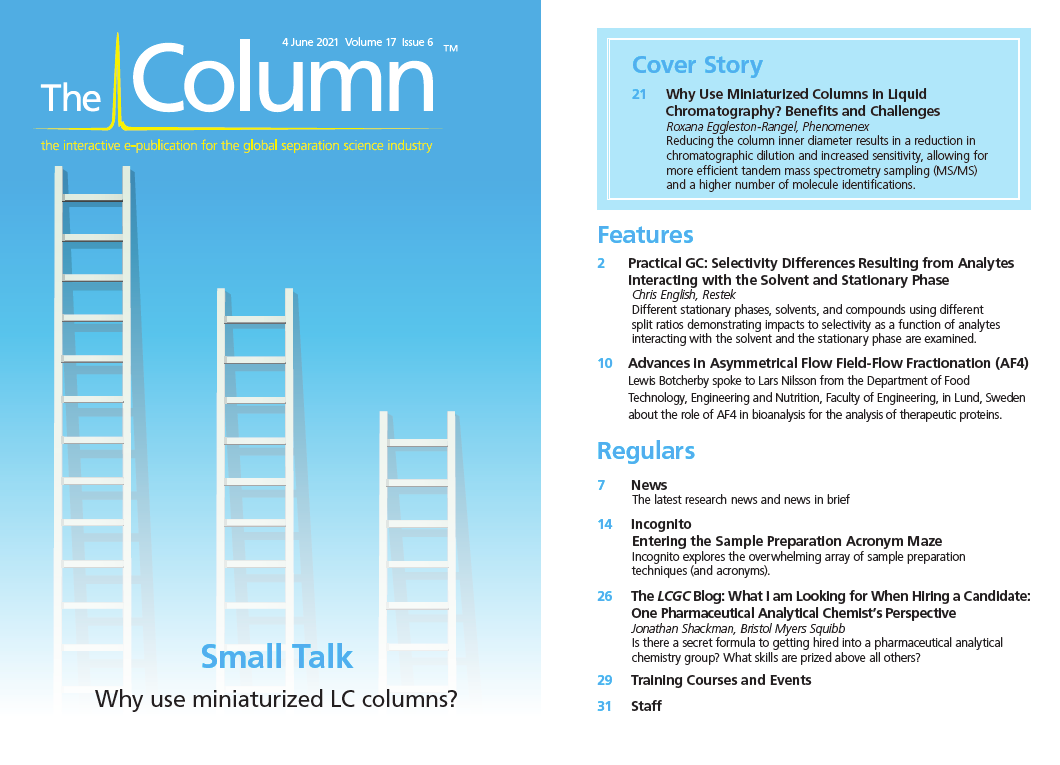Advances in Asymmetrical Flow Field-Flow Fractionation (AF4)
Lars Nilsson from the Department of Food Technology, Engineering and Nutrition, Faculty of Engineering, in Lund, Sweden, discusses the evolution of asymmetrical flow field-flow fractionation (AF4) in bioanalysis for the analysis of therapeutic proteins.
Q. Protein-based drugs are becoming increasingly important; however, the inherent complexity of proteins can present some challenges during processing, formulation, and storage. What are some of the issues that protein‑based drugs present and what effect do they have?
A: Compared to small-molecule drugs, proteins are often more sensitive, for example, the proteins are often sensitive to pH, salt concentration, and organic solvents. This has implications mainly for the stability of a protein-based drug, it should not degrade nor aggregate and should maintain its activity. Failure to address these issues may lead to a loss in efficacy or, in the worst case, the immunological responses in the patient.
Q. Protein analysis has relied heavily on size-exclusion chromatography (SEC) in combination with a suitable detector. What are the advantages and disadvantages of this technology for this purpose?
A: SEC is a well established workhorse technique that offers high resolution and is relatively easy to operate. If a liquid chromatography (LC) instrument is available, the only additional hardware that is needed is the SEC column. The disadvantages come into play when analyzing samples under specific conditions, such as in a pharmaceutical formulation. Successful SEC separations often require a certain level of salts to be used in the mobile phase, which might not be appropriate for the protein or formulation under investigation. In particular for biological matrices, when analyzing for protein complexes or other large components, the packed column may either get clogged or the sample degraded because of the high shear forces in the column.
Q. Understanding how protein therapeutics behave following administration is a difficult but crucial step. Can you speak to the importance of understanding the interactions of protein therapeutics post-administration and the difficulties of studying them?
A: While the quality of the protein drug product is, of course, important, it matters little if the protein-based drug fails upon administration. For example, if there are undesirable interactions, such as a fast and irreversible association between the protein drug and blood components, it will have a negative effect on efficacy. The challenge is to study the therapeutic drug in the vast amounts of endogenous proteins and other components present in the body. To be able to follow the component of interest, some type of selective detection is needed.
Q. Sample preparation is always an important consideration for complex analyses. What sample preparation is required when analyzing protein-based drugs? Are there any issues in carrying out sample preparation on these complex proteins or the matrices?
A: The sample preparation is very much governed by the analytical method used. The commonly applied sample preparations used for small-molecule drugs, such as precipitation with organic solvents, salts or changes in pH, or liquid–liquid extraction, are not always possible to use for protein drugs because they may severely alter the protein state, which is what we are analyzing.
Q. In a 2018 study you investigated the suitability of AF4 for high-resolution separation of proteins and other components in serum and plasma and the separation of whole blood without sample pretreatment (1). What are the features of AF4 that make it suitable for these analyses?
A: The open separation channel of AF4 offers certain benefits, mainly that the sample components will experience relatively lower shear forces and that the surface area is much smaller than in a packed column. The smaller surface area considerably decreases sample interaction with the separation device. The open channel also makes it less susceptible to clogging as a result of large-sized components in the sample.
Q. What were the conclusions of this study?
A: That it is possible to monitor a fluorescently labelled antibody in serum and plasma samples with very little sample preparation. The only sample preparation was a dilution step, which was mainly performed to ensure accurate functioning of the autosampler.
Q. This paper was followed up with another study published in 2020, which coupled surface plasmon resonance (SPR) to AF4 for the analysis of active fractions of bio-separations in real samples, such as serum or saliva (2). What exactly is SPR and what are the benefits of using it for this purpose?
A: The analysis of proteins in biological fluids requires a selective detection. While the use of fluorescently labelled analytes works well, it may not always be desirable or possible to fluorescently label the analyte. Labelling may affect analyte behaviour and therefore the option to detect the unlabelled protein is very attractive.
Surface plasmon resonance is a phenomenon in which small changes on a surface, such as adsorption of protein, can be monitored. In essence, the refractive index of the surface changes if there is sample interacting with the surface. The phenomenon is used in a wide range of instruments and can be employed for studying a wide range of materials—proteins, polymers, and nanoparticles to name a few. We used SPR in an immunoassay configuration, with the surface coated with an antibody selective against our target analyte. In this configuration, SPR offered the sensitive and selective label-free detection needed for the complex matrices we were investigating.
Q. What are the future applications of this methodology and could it potentially be used in other areas?
A: We believe that the AF4–SPR combination could be of interest in pharmaceutical development during discovery phases, as well as in later stages. Both AF4 and SPR have individually been applied to many other types of analytes, so the combination has the potential to be applicable to a wide range of analytes. One particularly interesting avenue would be to use it for selective detection of nanoparticles and viruses in biological fluids.
Q. What other applications is AF4 commonly used for?
A: AF4 has been used for analyzing macromolecules in solution and colloidal dispersions. These areas are pharmaceutically relevant and AF4 is especially interesting since the complex samples often cover a wide size range that few other techniques have the ability to separate. It may be proteins, biopolymers, polymers, and nanoparticles, or combinations of them. There are continuous improvements in the technique, allowing higher resolution and sensitivity through different channel designs. In particular, I believe that combining AF4 with different detectors, such as SPR or mass spectrometry (MS), can offer synergies and answer questions that none of the techniques could by themselves.
Q. What are you currently working on?
A: We are currently looking into combining AF4 with another selective detector—MS—for the analysis of proteins in biological fluids. We are heavily involved in the NextBioForm consortium, which addresses the formulation of next‑generation biologics (3). Part of this research focuses on understanding and controlling chemical degradation, such as isomerization and deamidation, in relation to structure and conformation of therapeutic proteins in solution. Another area focuses on understanding interface-induced aggregation of therapeutic proteins.
References
- M. Leeman, J. Choi, S. Hansson, M. Ulmius Storm, and L. Nilsson, Analytical and Bioanalytical Chemistry 410, 4867–4873 (2018). https://doi.org/10.1007/s00216-018-1127-2
- M. Leeman, W.M. Albers, R. Bombera, J. Kuncova-Kallio, J. Tuppurainen, and L. Nilsson, Analytical and Bioanalytical Chemistry 413, 117–127 (2021). https://doi.org/10.1007/s00216-020-03011-x
- https://www.ri.se/en/nextbioform

Lars Nilsson is Professor of Formulation Technology at Lund University in Sweden, and co-founder of the spinoff CRO SOLVE Research and Consultancy AB, which offers analysis by AF4, MALS, and other techniques as a service. His research focuses on applied colloid chemistry and formulation technology, as well as development and application of AF4 methodology for the separation and characterization of biomacromolecules and nanoparticles within the life sciences. The AF4 work is currently directed towards analysis of therapeutic proteins and peptides in product formulation and biological fluids.












